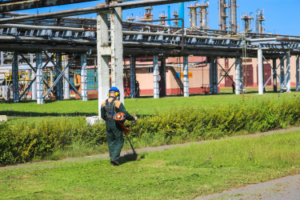If you own a business or rent out a commercial property, there is various different health and safety documentation that you need to be aware of. One of these documents is a Risk Assessment Method Statement document, otherwise known as a RAM.
What are RAMS?
Risk Assessment Method Statements, or RAMS, are documents that follow a risk assessment. They are different to a risk assessment document as these documents identify hazards in the workplace and analysef present risks. RAMS, on the other hand, contain details of the hazard, as well as a step-by-step safe-working guide that can be followed by employees, contractors and visitors. These documents, therefore, are a lot more detailed than risk assessments. If you think of a risk assessment as the document identifying the problem, a RAMS is there to provide guidance on how to solve it safely.
RAMS can be implemented in any business or sector, but they are most frequently used in the construction, facilities management or manufacturing industries, as workers are more likely to be using dangerous equipment or working in high-risk environments.
What is included in RAMs documents?
In a RAMS document you can expect to find:
- Risk assessment: This involves identifying and evaluating potential hazards and risks associated with the task or activity. It includes assessing the likelihood and severity of each risk.
- Control measures: The RAMS outlines the measures that will be implemented to eliminate or reduce the identified risks. This may include engineering controls, administrative controls, personal protective equipment (PPE), and other safety measures.
- Method statement: This section describes the step-by-step procedures and precautions that will be followed to carry out the task safely. It includes details such as equipment to be used, work practices, and specific instructions for hazard control.
- Emergency procedures: RAMS also includes information on emergency procedures, including evacuation plans, first aid measures, and contact details for emergency services.
- Responsibilities and communication: RAMS identifies the individuals or roles responsible for implementing the risk assessment and ensuring compliance with safety measures. It also specifies the communication channels for sharing the RAMS information with relevant personnel.
Why are RAMS important?
The implementation of RAMS documents is very important in high-risk environments for a number of reasons:
Safety
RAMS help identify potential hazards and risks associated with an activity. By conducting a thorough risk assessment, organisations can implement appropriate control measures to minimise these risks. This ensures the safety and well-being of workers and other individuals involved in the activity.
- Legal compliance: Many countries have stringent occupational health and safety regulations that require employers to assess and manage risks in the workplace. RAMS provide a documented and systematic approach to meeting these legal requirements.
- Risk mitigation: RAMS provide a structured framework for identifying and evaluating risks. By systematically assessing risks, companies can identify effective control measures to mitigate them. This proactive approach reduces the likelihood of accidents, injuries, or damage to property.
- Communication and awareness: RAMS serve as a communication tool to convey important safety information to workers and other stakeholders involved in the activity. It helps create awareness about potential hazards, control measures, and safe work practices. Clear communication ensures that everyone understands their roles and responsibilities, leading to safer work environments.
- Efficiency and productivity: By identifying risks and implementing appropriate control measures, RAMS can help prevent work disruptions caused by accidents or injuries. Safe work practices and hazard controls outlined in RAMS contribute to improved efficiency, productivity, and continuity of operations.
- Continuous improvement: RAMS facilitate a culture of continuous improvement in occupational health and safety. As new risks are identified or existing control measures are found to be inadequate, RAMS can be updated and improved.
Regular review and revision of RAMS help organisations to stay proactive in managing risks and adapting to changing work environments.
Overall, RAMS play a vital role in ensuring the safety of workers, compliance with legal requirements, and the efficient operation of businesses. They provide a structured approach to risk assessment and management, helping organisations create safer work environments and prevent accidents and injuries.
How Dependable can help
Following your RAMS, Dependable can provide hard and soft facilities management services to help you make your building safer for your employees and customers. Our facilities management services include gas and electrical safety checks, plumbing and heating servicing, fire safety inspections and alarm servicing, and more.
If you want to learn more about how Dependable can help you, please get in touch today and we will be happy to help.




